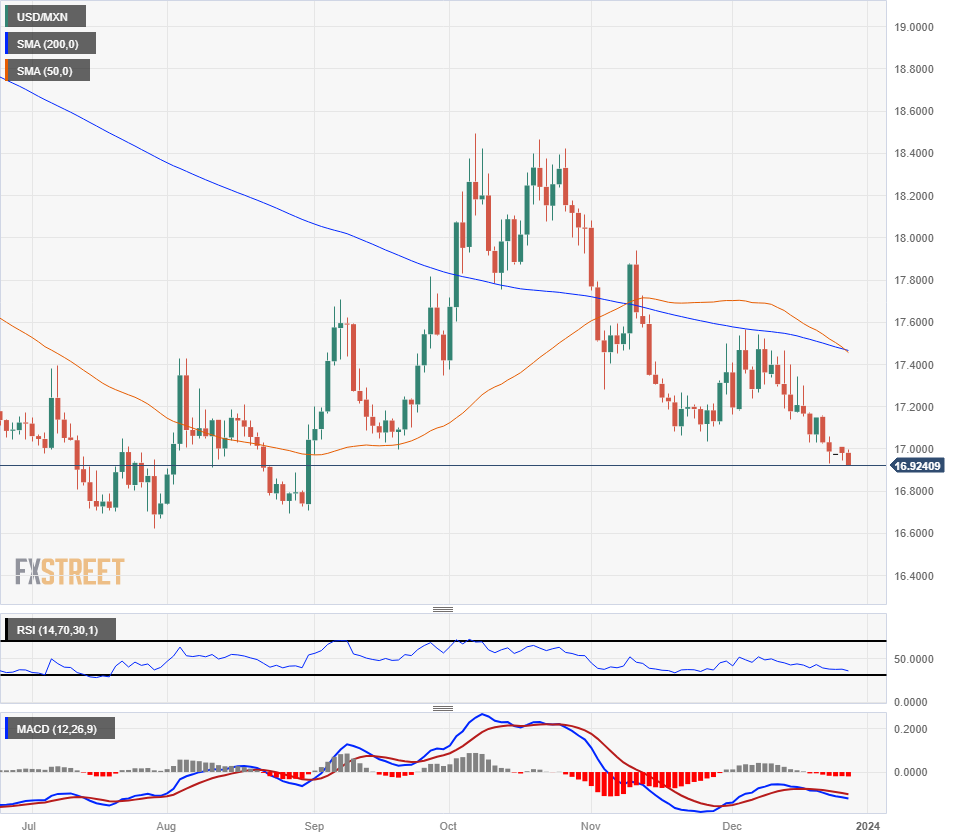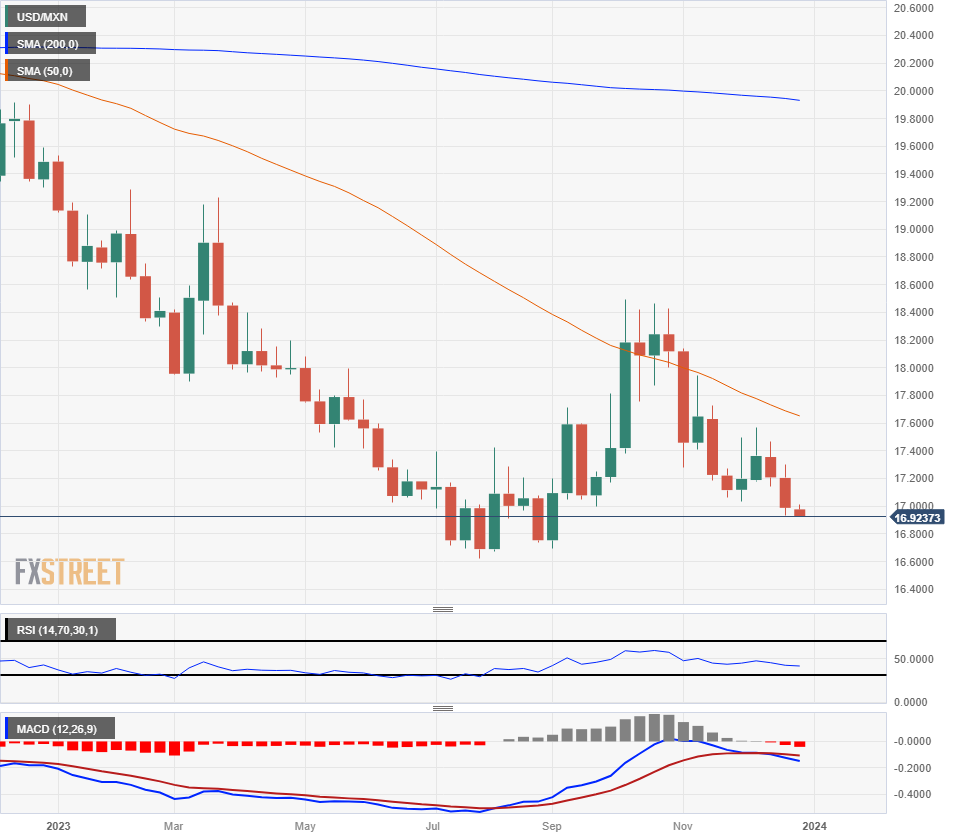Mexican Peso clings to highs as markets warm up post-holidays
- The Mexican Peso holds steady near familiar highs as markets head towards 2024.
- Mexico's Jobless Rate figures are due Thursday.
- A light week on the economic calendar sees only medium-impact data on the docket.
The Mexican Peso (MXN) is seeing choppy markets amidst post-holiday volume constraints but sticking close to recent highs as markets continue to lean into rate cut expectations from the Federal Reserve (Fed).
It’s a thin showing on the economic calendar for the shortened week heading into the new year, with October’s Mexico Jobless Rate slated for Thursday.
The Mexican Peso briefly tested a fresh 16-week high against the US Dollar (USD) before USD/MXN settled into a near-term trading range between 17.00 and 16.90.
Daily digest market movers: Mexican Peso testing highs amidst near-term chop as the year draws to a close
- The Mexican Peso has had a decent run, with the USD/MXN falling over three and a half percent from December’s peak of 17.56.
- December’s theme has been a Greenback selloff as markets gear up for Fed rate cuts in 2024.
- The US Dollar is deeply in the red for the month, falling across the major currency board and bolstering the Peso to multi-month highs.
- The US Richmond Fed Manufacturing Index dipped even lower in December, falling to -11 and accelerating past the market forecast of -7 following November’s -5 print.
- Softening economic data from the US increases the odds of further Fed rate cuts.
- Mexico’s November Jobless Rate due on Thursday, forecast to improve slightly from 2.7% to 2.6%.
- US Initial Jobless Claims for the week into December 22 and November’s US Pending Home Sales also on the docket for Thursday.
- US Initial Jobless Claims expected to tick higher once more from 205K to 210K.
- US Pending Home Sales from November is forecast to rebound to 1% growth after October’s 1.5% contraction.
US Dollar price this month
The table below shows the percentage change of US Dollar (USD) against listed major currencies this month. US Dollar was the strongest against the Pound Sterling.
| USD | EUR | GBP | CAD | AUD | JPY | NZD | CHF | |
| USD | -2.09% | -1.35% | -2.77% | -3.71% | -4.35% | -3.11% | -4.01% | |
| EUR | 2.04% | 0.71% | -0.68% | -1.60% | -2.23% | -1.00% | -1.88% | |
| GBP | 1.33% | -0.72% | -1.42% | -2.33% | -2.96% | -1.74% | -2.62% | |
| CAD | 2.70% | 0.69% | 1.39% | -0.91% | -1.54% | -0.33% | -1.18% | |
| AUD | 3.57% | 1.57% | 2.29% | 0.91% | -0.60% | 0.57% | -0.28% | |
| JPY | 4.16% | 2.20% | 2.87% | 1.51% | 0.63% | 1.20% | 0.34% | |
| NZD | 3.01% | 1.00% | 1.71% | 0.32% | -0.58% | -1.21% | -0.87% | |
| CHF | 3.82% | 1.82% | 2.53% | 1.17% | 0.26% | -0.36% | 0.83% |
The heat map shows percentage changes of major currencies against each other. The base currency is picked from the left column, while the quote currency is picked from the top row. For example, if you pick the Euro from the left column and move along the horizontal line to the Japanese Yen, the percentage change displayed in the box will represent EUR (base)/JPY (quote).
Technical Analysis: Mexican Peso leans into recent highs on thin market volumes
The Mexican Peso (MXN) is seeing some gains in choppy post-holiday markets, rising 0.4% on Wednesday to a new 16-week high. Momentum is unlikely to materialize with market depth on the thin side heading into the new year, but overall market sentiment is keeping pressure on the US Dollar, keeping the Greenback on the low side.
The USD/MXN continues to be sold off after getting rejected from the 200-day Simple Moving Average (SMA) near 17.60, and the 50-day SMA is set to confirm a bearish cross of the long-term moving average as price action continues to tilt towards the downside.
The last trading week of 2023 is set to close out with the US Dollar on the back foot once more, and the USD/MXN pair is likewise heading for another down month as the Greenback waffles against the Peso.
The USD/MXN has so far closed in the red for all but three months of the year.
USD/MXN Daily Chart

USD/MXN Weekly Chart

Mexican Peso FAQs
What key factors drive the Mexican Peso?
The Mexican Peso (MXN) is the most traded currency among its Latin American peers. Its value is broadly determined by the performance of the Mexican economy, the country’s central bank’s policy, the amount of foreign investment in the country and even the levels of remittances sent by Mexicans who live abroad, particularly in the United States. Geopolitical trends can also move MXN: for example, the process of nearshoring – or the decision by some firms to relocate manufacturing capacity and supply chains closer to their home countries – is also seen as a catalyst for the Mexican currency as the country is considered a key manufacturing hub in the American continent. Another catalyst for MXN is Oil prices as Mexico is a key exporter of the commodity.
How do decisions of the Banxico impact the Mexican Peso?
The main objective of Mexico’s central bank, also known as Banxico, is to maintain inflation at low and stable levels (at or close to its target of 3%, the midpoint in a tolerance band of between 2% and 4%). To this end, the bank sets an appropriate level of interest rates. When inflation is too high, Banxico will attempt to tame it by raising interest rates, making it more expensive for households and businesses to borrow money, thus cooling demand and the overall economy. Higher interest rates are generally positive for the Mexican Peso (MXN) as they lead to higher yields, making the country a more attractive place for investors. On the contrary, lower interest rates tend to weaken MXN.
How does economic data influence the value of the Mexican Peso?
Macroeconomic data releases are key to assess the state of the economy and can have an impact on the Mexican Peso (MXN) valuation. A strong Mexican economy, based on high economic growth, low unemployment and high confidence is good for MXN. Not only does it attract more foreign investment but it may encourage the Bank of Mexico (Banxico) to increase interest rates, particularly if this strength comes together with elevated inflation. However, if economic data is weak, MXN is likely to depreciate.
How does broader risk sentiment impact the Mexican Peso?
As an emerging-market currency, the Mexican Peso (MXN) tends to strive during risk-on periods, or when investors perceive that broader market risks are low and thus are eager to engage with investments that carry a higher risk. Conversely, MXN tends to weaken at times of market turbulence or economic uncertainty as investors tend to sell higher-risk assets and flee to the more-stable safe havens.
